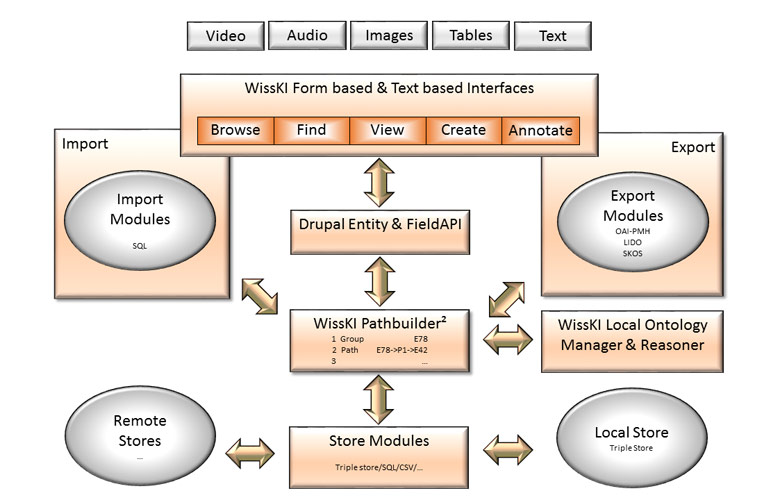WISSKI II - Scientific communication infrastructure
Projectduration: 2014 - 2016
Project Sponsorship: German Research Association (Deutsche Forschungsgemeinschaft, DFG)
The publication, archiving and long-term use of primary data are a central goal in research and are a concern not limited to the field of cultural heritage. Solutions are increasingly being sought in the application of semantic technologies, which are however often highly complex and to date have only been of an experimental nature.
In this context, the WissKI project, initiated by the GNM (Germanisches Nationalmuseum), ZFMK (Zoologisches Forschungsmuseum Alexander Koenig Bonn) and the Chair for Digital Humanities at the Friedrich Alexander University, Nuremberg-Erlangen, has, by creating Erlangen CRM, taken an important step towards turning the proposed solutions into practical applications.
During the project, a system based on internet technologies was developed that supports scientific communication and documentation in the area of cultural heritage with the help of ontology-based knowledge processing and systematically uses the ISO-certified CIDOC-CRM standard for data storage. For more information on the software platform that was created, visit www.wiss-ki.eu
Aim of the project
The aims of the follow-on project, WissKI II, are based on the research questions that arose in the preceding project and the feedback from the research community; they cover the following three areas:
1. Updating and further development of the existing software system
The current version of the WissKI software, which is based on a number of software components and technologies from third parties, will be updated to the latest version of the components. The maintenance and enhancement of the system will always be based on the requirements of the users in order to increase acceptance. In addition, the extension of the import/export interfaces will enable the system to be used by other user groups and in a range of system constellations in the future. WissKI will therefore grow to become a provider for linked data in accordance with current guidelines, and WissKI's semantic concept will be enhanced to include image, video and audio files.
2. Knowledge transfer in practical work with semantic technologies
On the basis of the knowledge gained in the project, a central point of contact will be set up for digital cultural heritage in the area of semantic technologies. This will provide scientists with assistance, advice and training in working with standards for the receipt of data, in particular from the CIDOC Conceptual Reference Model (CRM, ISO 21127). During the project, a portal is planned for the scientific community, and important topics will be provided in fora and mailing lists for discussion in scientific circles. The results will be published in the form of guidelines. Achieving a critical number of users and application scenarios is a central element in the planned ongoing concept. For the medium term, this should enable the WissKI system to be further developed and maintained even without public funding.
3. Support for the scientific knowledge acquisition process through semantic data processing
To enhance the existing retrieval mechanism, semantic analysis tools will be developed that help to answer scientific questions on complex matters with the help of user-friendly query templates. New visualisation methods such as maps, time lines or graphs will help to identify new relationships between the data. Furthermore, the use of inference mechanisms will extend the search options to include knowledge implicitly contained in the data, and will simplify data quality assurance by means of a consistency check.
Further information
Project-website
CIDOC-CRM Ontologie in OWL-DL 1.0 Database
WissKI on facebook
Team
Dr. Siegfried Krause (head of the project)
Kerstin Reinfandt M.A.
Partners
Prof. Dr.-Ing. Günther Görz (FAU)
Dipl.-Inf. Martin Scholz (FAU)
Dipl.-Inf. Dorian Merz (FAU)
Dr. Peter Grobe (ZFMK)
Maria Anna Pfeifer (ZFMK)

Information and Services
Plan Your Visit
Opening Times
Location and Approach
GNM Museum Shop
FAQ
Library
Branches
Contact

